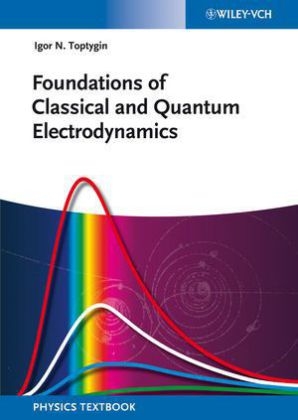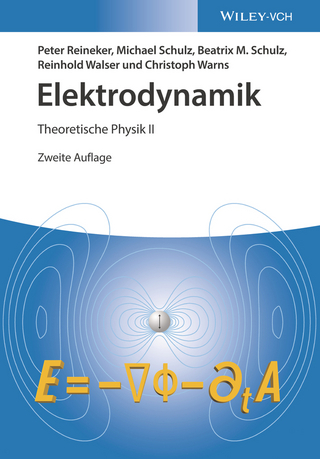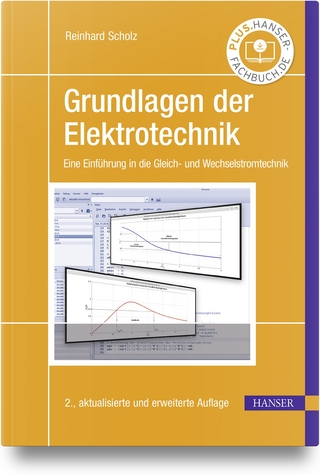
Foundations of Classical and Quantum Electrodynamics
Wiley-VCH (Verlag)
978-3-527-41165-8 (ISBN)
- Titel wird leider nicht erscheinen
- Artikel merken
The book introduces the material at different levels, oriented towards 3rd-4th year bachelor, master, and PhD students. This is so as to describe the whole complexity of physical phenomena, instead of a mosaic of disconnected data. The required mathematical background is collated in the first Chapter, while the necessary physical background is included in the main text of the corresponding chapters and also given in appendices.
The content is based on teaching material tested on students over many years, and their training to apply general theory for solving scientific and engineering problems. To this aim, the book contains approximately 800 examples and problems, many of which are described in detail. Some of these problems are designed for students to work on their own with only the answers and descriptions of results, and may be solved selectively. The examples are key ingredients to the theoretical course; the user should study all of them while reading the corresponding chapters.
Equally suitable as a reference for researchers specialized in science and engineering.
Igor N.Toptygin is Professor at the Theoretical Physics Department in Saint-Petersburg State Polytechnic University, Russia. He received his academic degrees in the field of physics and mathematics in 1964 (PhD) and 1974 (habilitation). He is an expert in theoretical physics and theoretical astrophysics. He is a member of the Scientific Council on Complex Problem of "Cosmic Rays" of the Russian Academy of Sciences, and a corresponding member of the International Academy of Sciences for High Education. He has been engaged for many years in theoretical studies of quantum paramagnetic amplifiers, acceleration of cosmic rays, radiation of relativistic particles in plasmas, etc.
Chapter 1. The mathematical methods of electrodynamics
1.1. Vector and tensor algebra
1.2. Vector and tensor analysis
1.3. Special functions of mathematical physics
1.4. Answers and solutions
Chapter 2. Basic concepts of electrodynamics. The Maxwell equations
2.1. Electrostatics
2.2. Magnetostatics
2.3. Maxwell equations. Electromagnetic waves
2.4. Answers and solutions
Chapter 3. The special theory of relativity and relativistic kinematics
3.1. Principle of relativity and Lorentz transformations
3.2. Kinematics of relativistic particles
3.3. Answers and solutions
Chapter 4. Fundamentals of relativistic mechanics and eld theory
4.1. Vectors and tensors in 4d space-time
4.2. Motion of charged particles in electromagnetic field. Transformation of electromagnetic field
4.3. Relativistic electrodynamics. Introduction in field theory
4.4. Answers and solutions
Chapter 5. Emission and scattering of electromagnetic waves
5.1. Green function and retarded potentials
5.2. Radiation from non-relativistic systems
5.3. Radiation of relativistic particles
5.4. Interaction of charged particles with radiation
5.5. Answers and solutions
Chapter 6. Quantum theory of radiation processes. Photon emission and scattering
6.1. Quantum states of electromagnetic field
6.2. Quantum theory of emission, absorption and scattering of photons by atoms
6.3. Interaction of relativistic particles with photons
6.4. Answers and solutions
Chapter 7. Fundamentals of quantum theory of the electron-positron field
7.1 Covariant form of Dirac equation. Relativistic
bispinor transformation
7.2 Covariant quadratic forms
7.3 Charge conjugation and wave functions of antiparticles
7.4 Secondary quantization of the Dirac field. Creation
and annihilation operators for the field quanta
7.5 Energy and current density operators for the Dirac
particles
7.6 Interaction between electron-positron and electromagnetic fields
7.7 Schrödinger equation for interacting fields and the
evolution operator
7.8 Scattering matrix and its calculation
7.9 Calculations of probabilities and effective differential cross sections
7.10 Scattering of a relativistic particle with a spin in
the Coulomb field
7.11 Green?s functions of electron-positron and electromagnetic fields
7.12 Interaction between electrons and muons
7.13 High-order corrections
7.14 Answers and solutions
Appendix 1. Systems of electric and magnetic quantities
Appendix 2. Variation principle for continuous media
Appendix 3. General scheme of quantum theory
References
Subject index
| Verlagsort | Weinheim |
|---|---|
| Sprache | englisch |
| Maße | 170 x 244 mm |
| Einbandart | gebunden |
| Themenwelt | Naturwissenschaften ► Physik / Astronomie ► Elektrodynamik |
| Naturwissenschaften ► Physik / Astronomie ► Theoretische Physik | |
| Technik ► Elektrotechnik / Energietechnik | |
| Schlagworte | Elektromagnetismus • Quantenphysik • Theoretische Physik |
| ISBN-10 | 3-527-41165-8 / 3527411658 |
| ISBN-13 | 978-3-527-41165-8 / 9783527411658 |
| Zustand | Neuware |
| Informationen gemäß Produktsicherheitsverordnung (GPSR) | |
| Haben Sie eine Frage zum Produkt? |
aus dem Bereich


